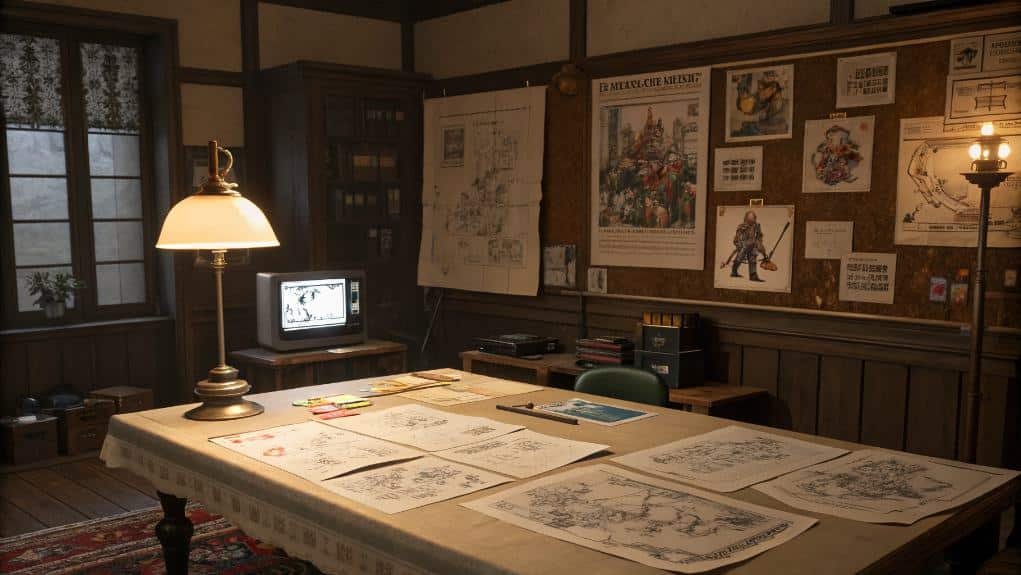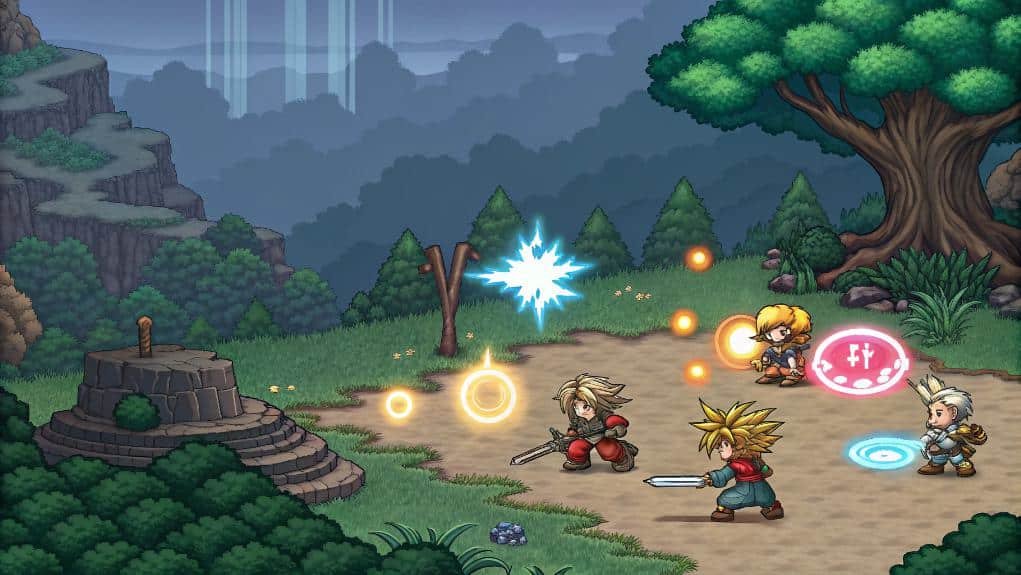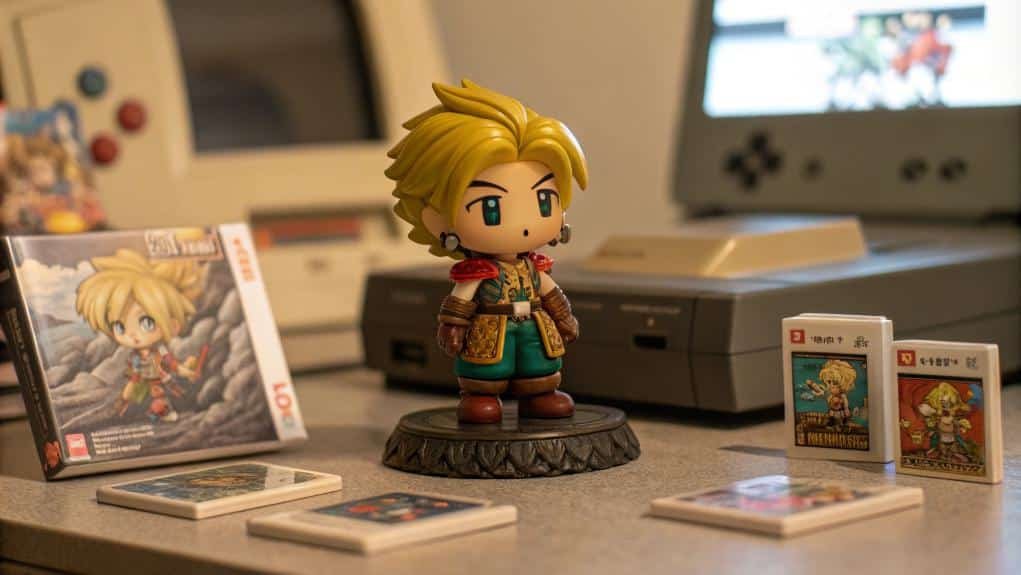Final Fantasy VI, released in 1994, revolutionized the RPG genre with its rich narrative and character-driven gameplay. Developed under tight timelines, it unified complex storylines and diverse character arcs, showcasing themes of resilience and transformation. The protagonist, Terra Branford, navigates her dual heritage amidst an oppressive Empire, while Kefka's chaos escalates the stakes. Innovative mechanics like the Active Turn Battle system and the strategic use of Magicite featured prominently in gameplay. The game garnered critical acclaim for its emotional depth and immersive music, leaving a legacy that continues to influence developers and audiences alike. There's much more to this iconic title's journey.
Key Takeaways
- Final Fantasy VI was released in April 1994, marking a significant evolution in the RPG genre with its innovative gameplay and storytelling.
- The game features a rich narrative centered around Terra Branford's struggle against the oppressive Empire and the chaos brought by antagonist Kefka.
- Its Active Turn Battle system introduced strategic depth, while unique character abilities and the Magicite system enhanced combat tactics and gameplay diversity.
- Critical acclaim followed the game for its complex themes, character development, and impactful music, setting new benchmarks in video game storytelling.
- The enduring legacy of Final Fantasy VI is evident through numerous re-releases and adaptations, influencing future RPGs and the gaming industry as a whole.
Development and Conception

How did the development of Final Fantasy VI manage to blend creativity with technical constraints? The team faced significant development challenges, including a short one-year timeline and the need to manually manage memory, which often led to human errors.
Despite these limitations, they adopted a collaborative approach, allowing each member to contribute unique character episodes. This teamwork resulted in rich character dynamics, making each character feel like a protagonist in their own right. Character designs, including those for Shadow and Setzer, emerged through this team collaboration, showcasing the innovation in their development process.
Yoshinori Kitase, one of the directors, unified various scenarios into a coherent narrative, while producer Hironobu Sakaguchi provided the foundational story premise. Tetsuya Nomura's monster designs and Kaori Tanaka's character suggestions, like those for Edgar and Sabin, were instrumental in building the game's emotional depth.
The emphasis on character creation allowed players to form lasting connections, even as the team struggled to balance the diverse cast.
Ultimately, the developers found freedom within strict boundaries, turning technical limitations into opportunities for innovation. By focusing on character-driven storytelling and intertwining individual narratives, Final Fantasy VI set a new standard for emotional engagement in the RPG genre.
Storyline Overview
The storyline of *Final Fantasy VI* intricately weaves together a rich tapestry of character arcs and thematic depth, beginning with the haunting introduction of Terra Branford. Initially under the Empire's control, Terra's journey begins on a mountain near Narshe, where a fateful encounter with the Esper Valigarmanda leads to her liberation from mind control. This pivotal moment sparks her quest for identity and purpose, marking the beginning of significant story progression.
As the narrative unfolds, key events reveal the Empire's malicious plans and the personal vendettas of characters like Cyan, who seeks revenge after the tragedy in Doma. The story also emphasizes the Empire's imperialistic ambitions, showcasing its ruthless pursuit of power through the exploitation of Espers.
The stakes escalate when Kefka, the game's primary antagonist, betrays the Emperor, plunging the world into chaos and destruction. This act not only reshapes the power dynamics but also scatters the heroes across a devastated landscape.
The climax sees the Returners unify against Kefka, culminating in a battle that restores balance. Ultimately, the resolution highlights character growth, as Terra and others find renewed purpose amidst loss.
*Final Fantasy VI* presents a profound exploration of resilience, making its storytelling resonate long after the final credits roll.
Characters and Their Roles

In "Final Fantasy VI," Terra Branford stands out as the main protagonist, embodying the struggle between her dual heritage and the forces of oppression.
In stark contrast, the villainous Kefka Palazzo serves as the embodiment of chaos, manipulating events to further his own twisted ambitions.
Together, their complex interactions drive the narrative, highlighting themes of identity, morality, and the consequences of power. The game features a diverse cast of characters, each with unique abilities and roles that contribute to overall gameplay dynamics.
Main Protagonist: Terra Branford
Terra Branford stands as a complex and pivotal figure in Final Fantasy VI, embodying the struggle between identity and agency. As a half-human, half-Espere, her journey explores themes of self-discovery and empowerment. Initially passive and confused due to her captivity and amnesia, Terra's growth unfolds dramatically throughout the narrative.
- She transforms from a mere pawn of the Gestahlian Empire to a key player in the revolutionary movement known as the "Returners."
- Her Esper heritage grants her unique magical abilities, enabling her to confront powerful adversaries. In fact, her special ability to enter a Trance state doubles her attack and magic stats temporarily, showcasing her immense potential.
- Terra evolves into a protective mother figure for the orphans in Mobliz, highlighting her nurturing instincts.
- The ability to enter a Trance state allows her to release her full potential, symbolizing her reclaiming of agency.
Throughout her journey, Terra's character development resonates deeply with players. By bridging the gap between worlds and releasing Espers against the Empire, she exemplifies the triumph of personal growth over oppression.
Terra Branford's story ultimately reflects the power of choice, resilience, and the quest for identity in a world fraught with conflict.
Antagonist: Kefka Palazzo
From the moment Kefka Palazzo enters the scene as the court jester and a general of the Gestahlian Empire, he captivates players with his chaotic and malevolent charisma. His motivations stem from a deep-seated nihilism, shaped by a traumatic upbringing in an orphanage where he endured abuse. This background fuels his desire for power and destruction, making him a compelling antagonist.
Kefka's philosophy revolves around the belief that life is ultimately meaningless, which justifies his sadistic actions. He revels in manipulating others, such as when he enslaves Terra to lead attacks for the empire or poisons the water in Doma Castle, showcasing his complete disregard for human life. His transformation into a nihilistic psychopath is a direct result of the Magitek infusion that grants him magical abilities.
Once he breaks free from Gestahl's control, he embraces his role as the "God of Magic," seeking to reshape the world into a bleak landscape of his design.
In the World of Ruin, his reign of terror solidifies his status as a symbol of chaos. Kefka's destructive nature resonates with players, making him not just a villain, but an embodiment of despair and the dark side of ambition within the Final Fantasy VI narrative.
Themes and Narrative Depth
Final Fantasy VI weaves a rich tapestry of themes and narrative depth that resonates powerfully with players. The game's thematic exploration goes beyond mere conflict representation, diving into redemption themes and the complexities of war. Each character arc embodies emotional resonance, inviting players to connect deeply with their struggles.
- Terra's journey from Empire-controlled slave to symbol of hope highlights personal transformation.
- Celes's evolution from an imperial general to a compassionate ally showcases redemption.
- The non-linear storytelling enhances the narrative complexity, allowing players to explore character-driven quests.
- Symbolism analysis reveals profound contrasts, such as the dichotomy between Celes and Terra, representing celestial versus earthly struggles.
The story intricately examines loss, love, and the struggle for independence, particularly through characters like Locke and Cyan. Additionally, characters experience significant personal growth throughout the game, reflecting the theme of character development.
The narrative's depth is enriched by the interplay of fourteen unique characters, each contributing to a multifaceted experience.
Kefka's nihilism contrasts starkly with the hopeful arcs of the protagonists, emphasizing the overarching victory of light over darkness.
Ultimately, Final Fantasy VI's themes and narrative depth create a lasting impact, compelling players to reflect on their own journeys.
Gameplay Mechanics

In the domain of gameplay mechanics, Final Fantasy VI presents a sophisticated blend of systems that enhance both strategy and immersion. Central to its combat is the Active Turn Battle (ATB) system, where characters and enemies act based on their Speed stats. Players must develop effective battle strategies, adapting to encounter types like Pincer Attacks or Pre-Emptive Strikes, which influence initial ATB gauge states. Character abilities play an essential role; each character boasts unique skills, such as Locke's Steal and Celes' Runic. Furthermore, the use of magicite allows characters to learn spells and summon powerful Espers, adding layers to combat mechanics. The introduction of relics further enriches gameplay, providing diverse effects that can enhance abilities and change battle dynamics. Winning battles grants experience and rewards adds an incentive for players to engage in combat and refine their strategies.
Exploration elements include traversing the overworld and dungeons, where players encounter puzzles and shops. The menu screen serves as a hub for managing party composition and equipment. Collectively, these components create a rich tapestry of gameplay, encouraging players to experiment with different strategies and character configurations while engaging deeply with the game's world.
Release and Reception
Final Fantasy VI's initial release marked a pivotal moment in the RPG genre, capturing audiences with its rich storytelling and memorable characters. Critics lauded the game for its innovative design and emotional depth, earning it numerous accolades and a lasting legacy that continues to influence modern titles. As it underwent various re-releases across platforms, its acclaim only grew, solidifying its status as a cornerstone of gaming history. The introduction of the Magicite system allowed players to control spells and summon powerful allies, further enhancing the gameplay experience.
Launch and Initial Reception
Upon its release in April 1994, "Final Fantasy VI" quickly captured the attention of gamers in Japan and North America, marking a significant moment in the RPG genre. The game debuted as "Final Fantasy III" in North America, due to prior titles not being released in the region, but it didn't diminish its launch impact. Initial sales soared, with over 3.48 million copies sold worldwide by 2003, showcasing the game's commercial success.
- Developed and published by Square, it set a new standard for storytelling in video games.
- Localization changes in the North American version reflected cultural sensitivities, yet retained the game's essence.
- The game's strong sales across Japan, North America, and Europe solidified its status as a leading RPG.
- Subsequent re-releases on platforms like PlayStation and Game Boy Advance further expanded its audience, while it was also noted as the last title to feature 2D sprite-based graphics.
"Final Fantasy VI" established a legacy that not only influenced future RPGs but also cemented the Final Fantasy series as a powerhouse in the gaming industry.
Its initial reception laid the groundwork for ongoing interest and preservation through various re-releases, ensuring its timeless appeal.
Critical Acclaim and Awards
Lauded for its innovative approach to storytelling and character development, "Final Fantasy VI" garnered critical acclaim that resonated well beyond its initial release. Its impact on the RPG genre is undeniable, as it's often regarded as a watershed title that set new standards for narrative depth and emotional engagement. Critics praised its graphics, memorable soundtrack, and intricate character arcs, making it a benchmark for future games in the series. Notably, its legacy continues to influence contemporary titles, as seen with the recent JRPG dominance highlighted by new entries like "Final Fantasy 7 Rebirth."
The game's critical reception can be summarized as follows:
| Element | Recognition | Notable Impact |
|---|---|---|
| Graphics | Lauded for artistic design | Enhanced immersion in the world |
| Soundtrack | Considered one of the best in gaming history | Contributed to emotional storytelling |
| Character Design | Deep, multi-dimensional characters | Elevated player investment |
| Story | Complex themes and mature narratives | Redefined storytelling in RPGs |
| Villain | Kefka's uniqueness | Set a new standard for antagonists |
With over 3.48 million copies sold worldwide by 2003, "Final Fantasy VI" not only achieved commercial success but also cemented its legacy as a transformative force in the role-playing genre.
Legacy and Re-releases
The enduring legacy of "Final Fantasy VI" is evident through its numerous re-releases and adaptations, showcasing its lasting appeal to both new and veteran players. Initially launched in 1994, this landmark title quickly established itself as a cornerstone of the RPG genre, shaping the expectations of subsequent games.
Its cultural significance is underscored by the dedicated fan community that has continually celebrated its rich narrative and innovative gameplay.
Over the years, "Final Fantasy VI" has seen several re-releases, including:
- A 1999 port to PlayStation, introducing the game to a new audience
- The 2006 Game Boy Advance version, which added new content and features
- Availability on the Wii's Virtual Console in 2011 for nostalgic players
- The 2023 Pixel Remaster, enhancing graphics and soundtrack for modern consoles
These adaptations not only rejuvenated interest but also solidified its status among gaming classics.
With over 3.48 million copies sold by 2003 and a constant presence in gaming discussions, "Final Fantasy VI" remains an essential part of video game history, influencing both developers and players alike.
Its legacy continues to resonate in today's gaming landscape.
Lasting Impact on the Series

Few games have left as profound a mark on the RPG genre as Final Fantasy VI, which revolutionized narrative expectations and character development in video games. Its innovative storytelling and character complexity established a new standard that resonates to this day. By blending science fiction and fantasy, FFVI pushed boundaries, encouraging diverse narrative techniques that many titles have since emulated.
| Aspect | Influence on RPGs | Notable Features |
|---|---|---|
| Narrative Structure | Incorporated revolutionary plot twists | Major villain success and world destruction |
| Character Development | Strong cast with in-depth backstories | Distinctive personalities and moments |
| Gameplay Mechanics | Active-time battle system refinement | Unique abilities and magical diversity |
The game's thematic exploration of sensitive topics like depression and genocide marked a significant shift from family-safe content, prompting mature storytelling. Its gameplay evolution, including refined mechanics and innovative sequences, provided a template for future RPGs. Ultimately, Final Fantasy VI's cultural influence endures, inspiring both developers and fans alike, setting the groundwork for complex narratives in gaming.
Art and Visual Design
Final Fantasy VI's narrative and gameplay innovations are complemented by its striking art and visual design, which play a significant role in shaping the game's identity. Yoshitaka Amano's artistic influences, blending Art Nouveau, Pop art, and fantasy, define the game's aesthetic.
However, visual discrepancies between Amano's intricate concept art and the final sprite designs highlight the design evolution driven by technological limitations.
Key elements of the art and visual design include:
- Character Interpretations: Fans' varied interpretations of characters like Terra and Shadow showcase the richness of Amano's designs.
- Thematic Elements: The artwork features ornate technology and magical motifs, reinforcing the game's unique thematic tone.
- Color Symbolism: Vivid colors in characters' designs enhance emotional resonance and narrative depth.
- Fan Adaptations: Amano's distinctive style inspires a multitude of fan adaptations, reflecting a lasting appreciation of his work.
These stylistic choices not only create a fantastical world but also influence other artists and projects, leaving a profound legacy on video game art and fantasy genres as a whole.
Music and Soundtrack

Enthralling audiences with its innovative composition, the soundtrack of Final Fantasy VI stands as a landmark achievement in video game music. The game's music exemplifies soundtrack innovations through its musical diversity, blending classical and contemporary influences with orchestral arrangements, synthesizers, and a variety of instruments. Each character theme contributes to an immersive experience, enhancing the game's narrative depth.
The legacy analysis reveals how this soundtrack has influenced generations of composers, seamlessly integrating music into gameplay. Tracks like "Dancing Mad" and "Phantom Train" showcase thematic composition, with tempo changes and diverse styles that were groundbreaking for the time.
| Key Tracks | Character Themes | Cultural Influence |
|---|---|---|
| "Dancing Mad" | Kefka's Theme | Influenced JRPG music |
| "Phantom Train" | Figaro Castle | Orchestrated performances |
| "Opening Theme" | Main Character Themes | Academic interpretations |
Ultimately, Final Fantasy VI's soundtrack has left an indelible mark on the industry, establishing standards that continue to resonate within the domain of video game music. Its rich tapestry of sound encapsulates the essence of this iconic title.

